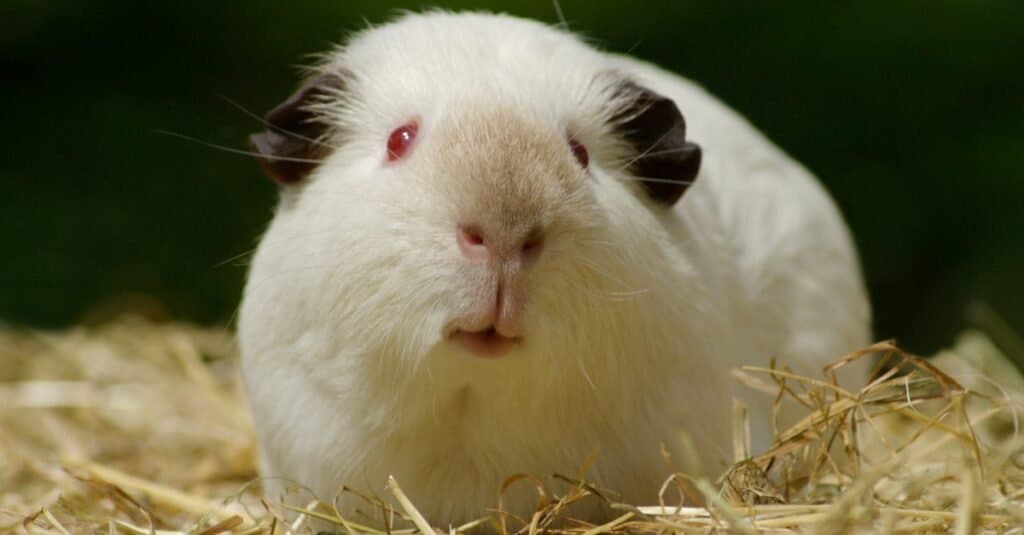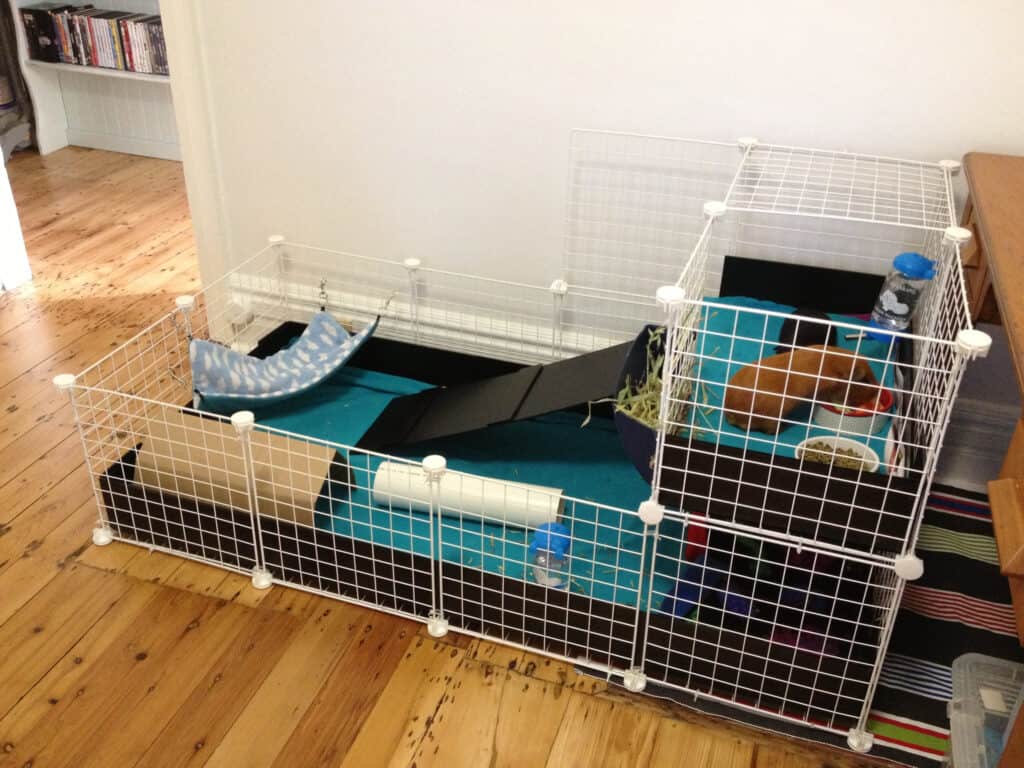Himalayan guinea pigs have striking colorpoints coats and gorgeous ruby-red eyes. Their fur is white with darker black or brown points around their eyes, noses, ears, feet, and tails.
Himalayan guinea pigs don’t require any special care if you already know how to care for guinea pigs. They need a large enclosure, at least one other guinea pig to live with, and a healthy diet consisting of hay, vegetables, and pellets. Despite common myths, guinea pigs aren’t easy “starter pets,” and there’s a lot of bad care advice out there!
In this article, we’ll discuss how to care for your Himalayan guinea pig and some more information about this beautiful breed.
Himalayan Guinea Pig Temperament

Himalayan guinea pigs are often skittish at first but can warm up to human handling.
©Pernille Westh/Shutterstock.com
Different breeds of guinea pigs tend to behave the same, though there are some myths out there about certain breeds!
Most Himalayan guinea pigs are docile pets, as guinea pigs don’t often bite–especially when handled properly. As prey animals, they can be skittish and require patient taming, though some are more outgoing than others.
Guinea pigs don’t tend to play like you’d expect from a dog or cat, but they do enjoy toys they can eat or chew on. They may toss them around the cage as well!
Himalayan Guinea Pig Care
Feeding
Himalayan guinea pigs need constant access to fresh water and hay. Guinea pigs have fast digestive systems and need to constantly eat–and poop!
They should also get a variety of dark, leafy greens and ⅛ cups of quality guinea pig pellets each day.
Adoption
Like all guinea pigs, Himalayans are herd animals. Under no circumstances should they be kept alone!
In the rare case that your Himalayan guinea pig cannot get along with others, they’ll still benefit from living side-by-side with another duo or group, sharing cage walls so that they can see, hear, and smell each other without physically interacting.
For beginners, we recommend adopting two to three guinea pigs who’ve already been bonded. Males can be kept in same-sex pairs or with as many females as you’d like, so long as they’re neutered.
Females can be kept in same-sex pairs or groups or with one neutered male. Males will fight over females given the chance, so don’t keep more than one in your female herd!
Housing

©Phil Whitehouse / flickr – License
The minimum cage size for two guinea pigs is 7.5 square feet according to the Humane Society of the United States, but many experienced caretakers recommend 10-12 square feet or larger. There’s no such thing as too big of an enclosure!
Of course, larger groups will need even more space. Males also tend to require more space than females. The cheapest cage is a homemade C&C (cubes and Coroplast) as pictured above, but you can also buy these cages online if you don’t feel like getting crafty!
When it comes to cage bedding, you can choose either something reusable like a fleece liner, or something disposable such as paper bedding. Reusable bedding creates a lot of laundry but is cheaper in the long term.
Avoid bedding that is scented, dusty, or uncomfortable to walk on. Himalayan guinea pigs can develop respiratory infections or bumblefoot from poor bedding or enclosure choices.
Guinea pigs like to hide, so be sure to provide them with at least one hiding spot per pig. This could be a hidey house, tunnel, or even a blanket covering a corner of the enclosure.
You’ll also want to provide one water bottle per guinea pig to reduce territorial behaviors. Toys are seen by some people as optional, but they’re a great idea for added enrichment. Just make sure to provide things that are safe to chew and eat, and don’t contain choking hazards.
Handling
Guinea pigs are prey animals, so you can’t expect them to interact in the same way as predator species like dogs and cats. Your Himalayan guinea pig will likely be skittish in their new environment and may be afraid of humans.
The best way to bond with your guinea pigs is to sit nearby and talk quietly to them. If their cage is on the ground, sit inside with some veggies and let them approach you. You can also do this during floortime!
When picking up your guinea pig, be sure to approach them from the side, not from overhead. Your hand reaching down and scooping them up resembles a hawk carrying them away and most piggies find this frightening.
Support their entire weight and keep them close to your chest to prevent injury while carrying them from place to place.
Veterinary Care and Lifespan
Give your Himalayan monthly or weekly health checks at home, looking over their bodies for symptoms of common ailments such as dental disease, parasites, fungal infections, respiratory disease, and ovarian cysts. Record their weight to ensure they aren’t gaining or losing without explanation.
Once every six months to a year, your Himalayan guinea pig should see an exotic pet veterinarian for a check-up.
Both of these things will help you to catch any illnesses early, which is crucial for guinea pigs. These animals are quite fragile and illnesses can progress to late stages very quickly.
The average guinea pig lives five to seven years, but they can live to be up to ten years old! Learning about common health conditions and keeping a close eye on your guinea pigs can help them live longer lives, as can feeding them correctly, housing them with piggy friends, and providing a large cage so they can exercise.
The photo featured at the top of this post is © Pernille Westh/Shutterstock.com
Thank you for reading! Have some feedback for us? Contact the AZ Animals editorial team.






